Specialist homelessness services client pathways: Young clients presenting alone in 2015–16
Citation
AIHW
Australian Institute of Health and Welfare (2022) Specialist homelessness services client pathways: Young clients presenting alone in 2015–16, AIHW, Australian Government, accessed 20 April 2024.
APA
Australian Institute of Health and Welfare. (2022). Specialist homelessness services client pathways: Young clients presenting alone in 2015–16. Retrieved from https://www.aihw.gov.au/reports/homelessness-services/shs-young-people-2015-16
MLA
Specialist homelessness services client pathways: Young clients presenting alone in 2015–16. Australian Institute of Health and Welfare, 07 June 2022, https://www.aihw.gov.au/reports/homelessness-services/shs-young-people-2015-16
Vancouver
Australian Institute of Health and Welfare. Specialist homelessness services client pathways: Young clients presenting alone in 2015–16 [Internet]. Canberra: Australian Institute of Health and Welfare, 2022 [cited 2024 Apr. 20]. Available from: https://www.aihw.gov.au/reports/homelessness-services/shs-young-people-2015-16
Harvard
Australian Institute of Health and Welfare (AIHW) 2022, Specialist homelessness services client pathways: Young clients presenting alone in 2015–16, viewed 20 April 2024, https://www.aihw.gov.au/reports/homelessness-services/shs-young-people-2015-16
Get citations as an Endnote file: Endnote
PDF | 1000Kb
On this page:
Study cohort – Specialist homelessness services: Young clients presenting alone in 2015–16
Introduction
Youth homelessness remains a persistent social problem in Australia and as such children and young people are a priority homelessness cohort (see Children and young people).
Longitudinal analyses have been undertaken for a cohort of younger clients (aged 15 to 24 years) who presented to SHS agencies alone (that is, not as part of a family group) at some time. These analyses are designed to examine SHS service usage patterns for a cohort of service users that can be tracked for a relatively similar period in the past and into the future.
See Introduction to the SHS longitudinal data for details on the longitudinal analysis undertaken.
The Young people presenting alone cohort (Young 2015–16) was defined as SHS clients that met the following conditions in any of the support periods in 2015–16:
- They were aged between 15 and 24 years (inclusive) at the time of presenting to an SHS agency in 2015–16.
- They presented alone (not as part of a couple or family group) while aged 15 to 24 years. This criterion limits the cohort to clients that attend SHS for their own needs. This is because the longitudinal analyses focus on pathways for individual clients, whereas children accessing services because of their parents or carers may need support for of issues that are unrelated to them directly.
The above is consistent with the approach used in other AIHW SHS publications such as the 2020–21 SHS annual report (AIHW 2021).
A comparison cohort (non-Young cohort) was also created, comprising clients aged 15 and over who did not meet the criteria for inclusion in the Young cohort. These clients were either young (aged 15 to 24) but did not present alone for services at any time during 2015–16, or they were aged 25 and over (no account was made of whether they presented alone or not). More information on the how comparison cohorts were derived can be found in the Methodology section.
The longitudinal SHS data for the period 2011–21 were used to (Figure Young.1):
- examine characteristics of young clients (the Young cohort) compared with the comparison cohort (the non-Young cohort)
- examine outcomes for the Young cohort in terms of historical and future service use.
The retrospective study period for this cohort is the 48 months before the start of the defining study period (that is, the 12 months from the start of their first mental-health related support period in 2015–16). The prospective study period is the 48 months after the end of each client’s 12 month defining study period.
Figure Young.1: Young people presenting alone cohort, longitudinal analysis overview
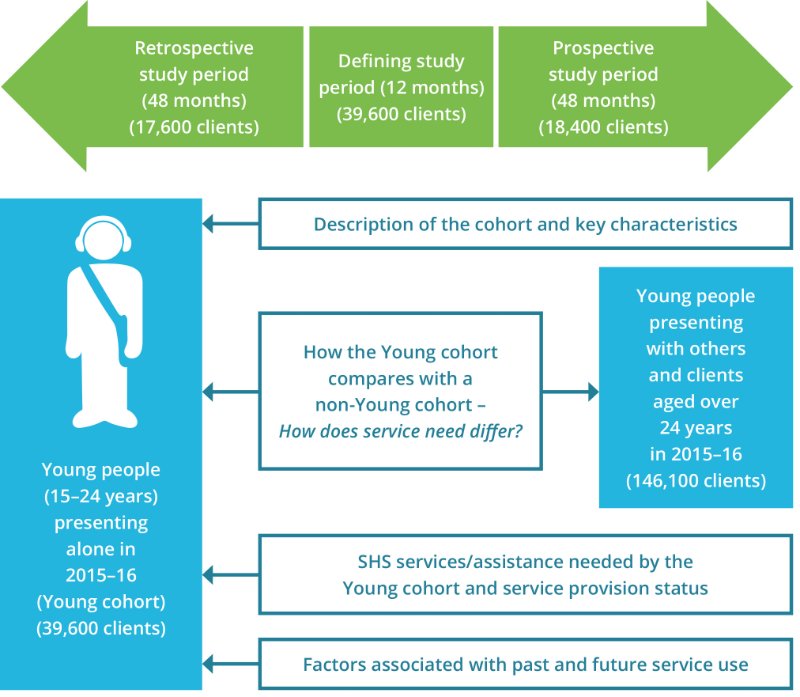
Source: AIHW analysis of SHS longitudinal data 2011–21, Table Young1516.1.
Key characteristics of the Young 2015–16 cohort
There were nearly 40,000 clients in the Young 2015–16 cohort; these clients had the following key characteristics (Table Young1516.1):
- One quarter of younger clients (10,100) were aged 15 to 17 years at the time of their first support period in 2015–16; the remaining 29,500 clients were aged 18 to 24 years.
- Around 11,000 clients (28%) were Indigenous.
- Nearly 4,400 clients (11%) were born overseas.
- Over half of clients (51%; 20,400 clients) had only one support period during the defining study period and 27% (10,600) had 3 or more support periods.
- Around 44% had used services previously; that is, 17,600 clients had used services in the 48-month retrospective period that preceded the defining study period.
- Around 46% of clients (18,400) continued to use services into the future; that is, they received support in the 48 months after the 12-month defining study period.
Service engagement profiles
Service use patterns of the Young cohort over the entire longitudinal period (2011–21) were examined. Over a third (14,600 or 37%) of the Young cohort were short-term clients (they only used services during the 12-month defining study period) (Figure Young.2, Table Young1516.1).
Figure Young.2: Young 2015–16 client cohort, service engagement profiles
This interactive bar chart shows service use patterns of the Young cohort over the entire longitudinal period (2011–21). Support information was combined from the discrete study periods into four service engagement profile groups (historical, short-term, long-term and ongoing). Engagement profiles for all states and territories and Australia can be selected and displayed. Nationally, of the 39,600 clients that made up the study period cohort, over a third (14,600 or 37%) of the Young cohort were short-term clients (they only used services during the 12-month defining study period). For VIC clients, 32% were short-term clients and had used SHS support during the defining period only and a similar proportion (33%) were long-term clients (used services in all study periods).
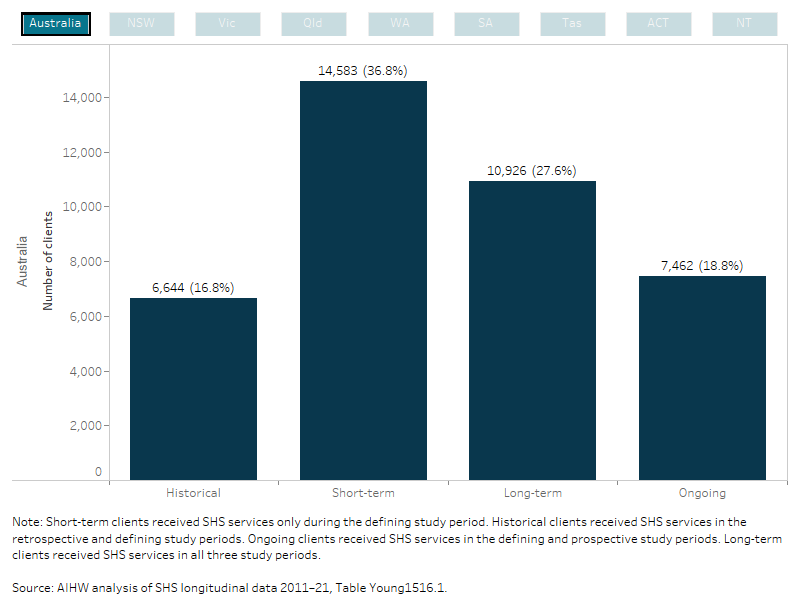
How the Young cohort compares with a non-Young cohort
Key comparisons between the Young and non-Young SHS clients, in 2015–16, include (Figure Young.3, Table Young1516.1):
- Young cohort clients were more likely to be Indigenous (28% compared with 21%) and less likely to be born overseas (11% compared with 18%). They were more likely to have had mental health issues (39% compared with 33%) during the defining study period.
- Young cohort clients were equally likely to have experienced FDV (around 36% to 37%).
- Young SHS clients were more likely to have needed short-term or emergency accommodation (47% compared with 38%), have received any accommodation assistance (34% compared with 27%), have been couch surfers (41% compared with 21%) or been homeless (63% compared with 48%).
- They were slightly more likely to have not been employed (83% compared with 79%), meaning they were either unemployed or not in the labour force at least once in the defining period.
Figure YOUNG.3: Young and non-Young cohort, client key characteristics, by study period, 2015–16
|
This interactive bar chart shows a comparison between the Young and non- Young cohorts, in terms of key characteristics and across all study periods (defining, retrospective and prospective). A radio button allows selection for the individual state/territory and Australia. For Australia, Young cohort clients were more likely to be Indigenous (28% compared with 21%) and less likely to be born overseas (11% compared with 18%). They were more likely to have had mental health issues (39% compared with 33%) during the defining study period. |
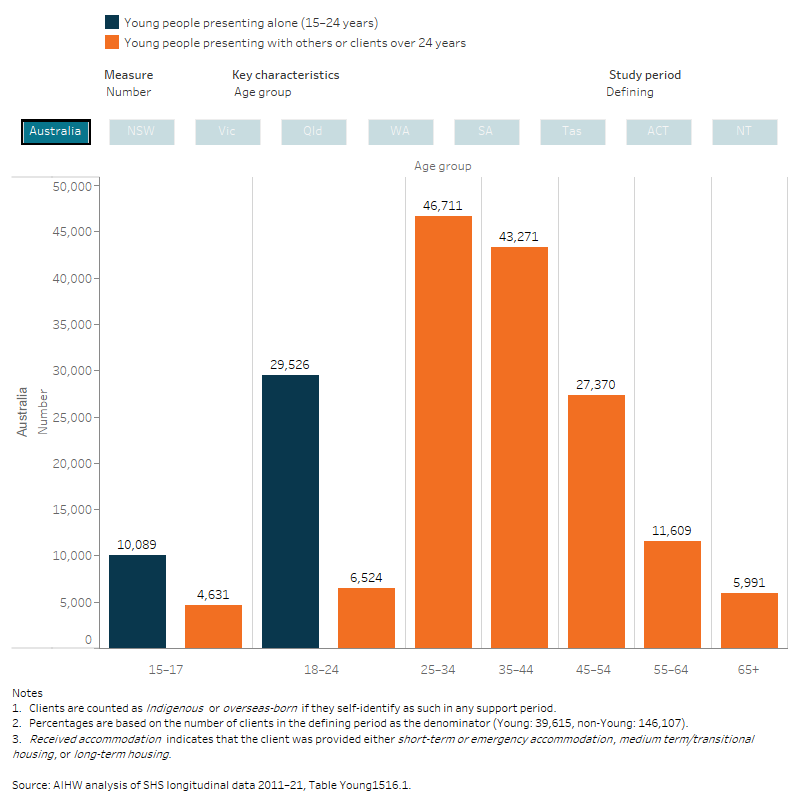
How did service needs differ?
Differences in identified service need between Young and non-Young clients were examined using relative risk, which was calculated by dividing the risk of an event occurring for one group (specifically, service need for each service type separately for Young clients) by the risk of an event occurring for another group (service need for non-Young clients).
Younger clients were nearly 5 times more likely to need training assistance (relative risk (RR) 4.81) during the 2015–16 defining study period than non-Young clients (Figure Young.4; Table Young1516.2).
Figure Young.4: Relative risk of needing a SHS service type, Young and non-Young clients, by study period, 2015–16
The interactive risk ratio plot shows the differences in service need between Young and non- Young clients receiving SHS support in each study period, these associations are presented as relative risks. The top 6 services more likely to be needed by Young cohort clients compared with non- Young clients (that is, those with the largest relative risk) have been shown in the figure. A radio button allows selection of the services and relative risks for each of the study periods (defining, retrospective and prospective). Younger clients were nearly 5 times more likely to need training assistance (relative risk (RR) 4.81) during the 2015–16 defining study period than non-Young clients. Young clients were also 2 to 3 times more likely to need pregnancy, employment and education assistance in all study periods.
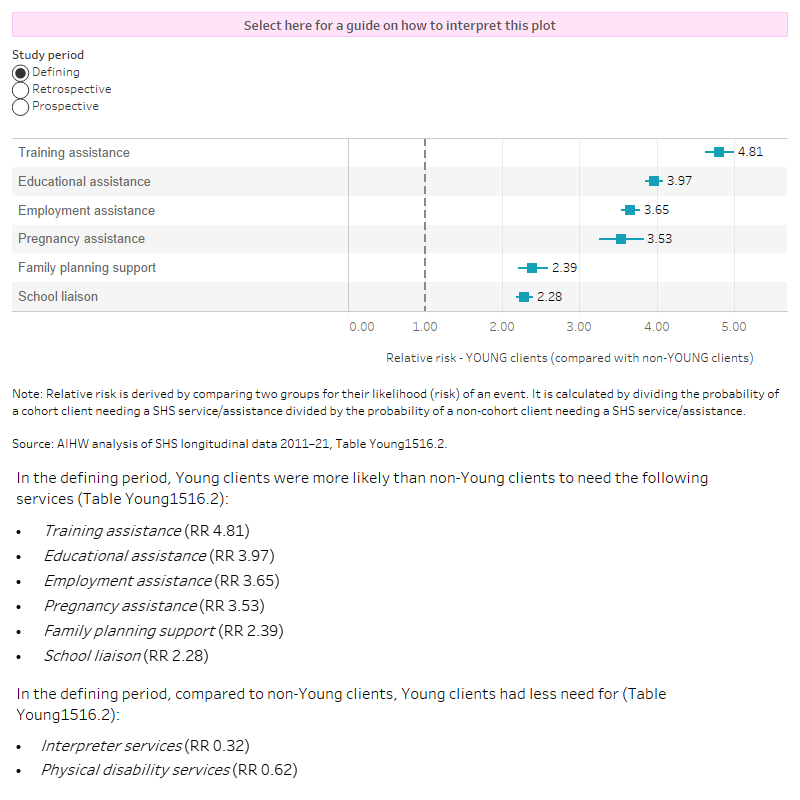
SHS clients – Young cohort past and future service use
Services provided by SHS agencies was examined for the Young cohort in each study period (Table Young.1, Table Young1516.1). Over one-third (36%; 14,100) of clients received their first support period in 2015–16 in Victoria, followed by 30% in New South Wales and 12% in Queensland.
The proportion of clients that used services in the past ranged from 37% of the defining cohort in New South Wales to 50% in Victoria. The proportion of clients that received SHS support in the future (after the defining study period) ranged from 40% in the ACT to 52% in Victoria.
Table Young.1. Young clients 2015–16, by past (retrospective) and future (prospective) service use and state/territory
The table shows the number and per cent of Young cohort clients within each study period for each state and territory and Australia. Over one-third (36%; 14,100) of clients received their first support period in 2015–16 in Victoria, followed by 30% in New South Wales and 12% in Queensland. The proportion of clients that used services in the past ranged from 37% of the defining cohort in New South Wales to 50% in Victoria. The proportion of clients that received SHS support in the future (after the defining study period) ranged from 40% in the ACT to 52% in Victoria.
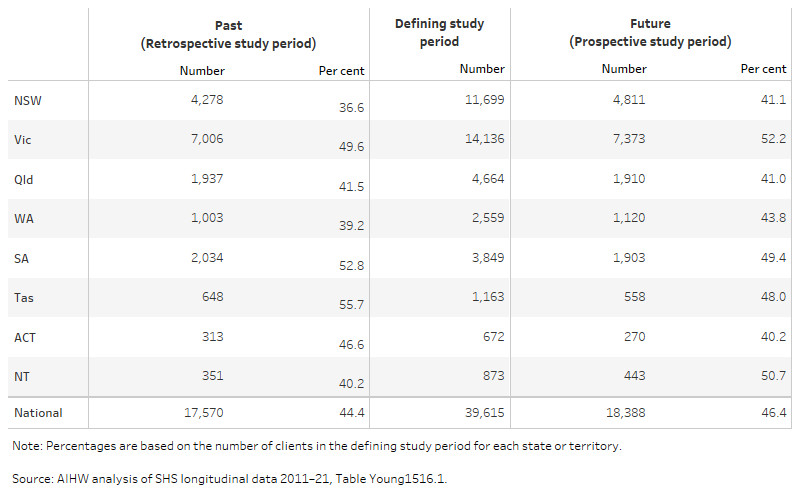
SHS services needed by Young cohort clients
Patterns of service need differed for Young SHS cohort clients across the 3 study periods. For example, the proportion of clients with a need for long-term housing was 42% in the defining period, 61% in the prospective period and 54% in the retrospective period. Similarly, a much smaller proportion of clients in the defining period needed assistance to sustain tenancy or prevent tenancy failure or eviction (35%) compared with 52% of clients in the prospective period and 44% in the retrospective period (Figure Young.5, Table Young1516.3).
Figure Young.5: Young clients 2015–16, select top 10 services and assistance needed and service provision status by study period
The interactive stacked horizontal bar graph shows the select top 10 services needed and the provision/referral status for the Young cohort clients (39,600 clients) that used services in the retrospective, defining and prospective study periods. Patterns of service need differed for Young SHS cohort clients across the three study periods. For example, the proportion of clients with a need for long-term housing was 42% in the defining period, 61% in the prospective period and 54% in the retrospective period. Similarly, a much smaller proportion of clients in the defining period needed assistance to sustain tenancy or prevent tenancy failure or eviction (35%) compared with 52% of clients in the prospective period and 44% in the retrospective period.
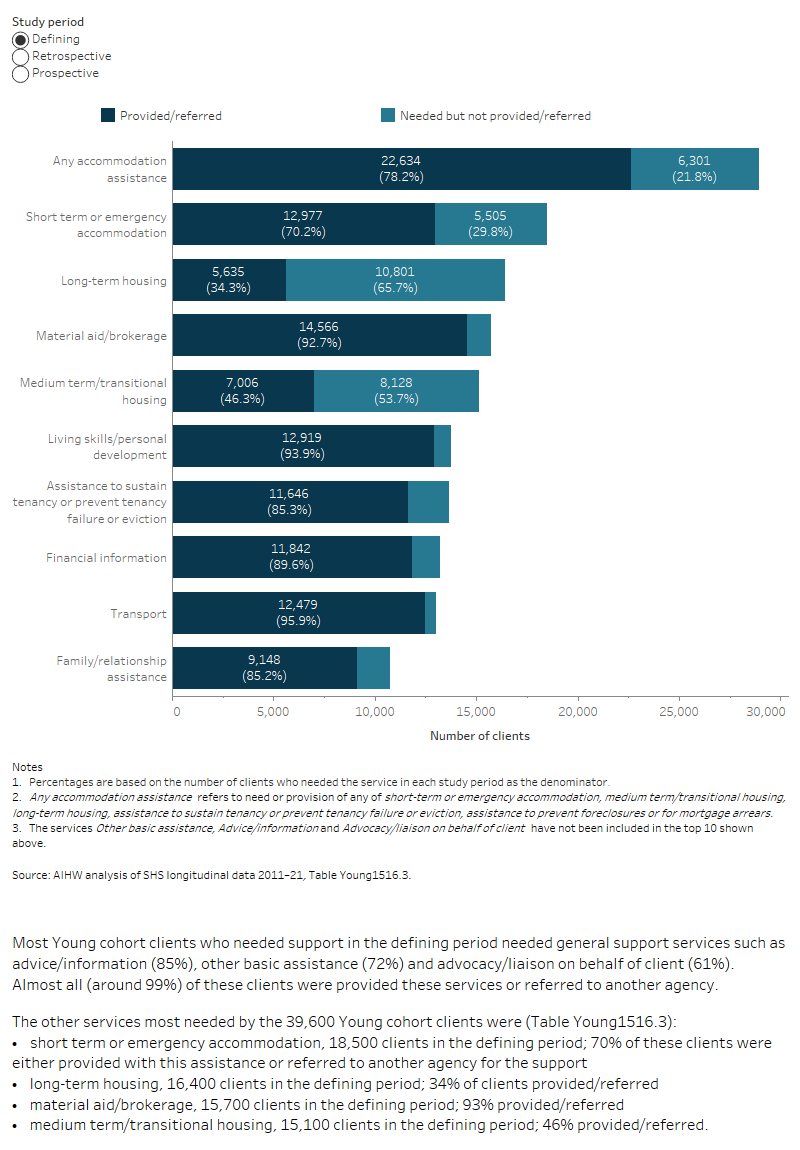
Factors associated with past and future SHS service use
Descriptive regression models were used to examine whether client characteristics or support experiences in the defining period were associated with receipt of SHS support in the prospective study period (ongoing service use) or, separately, in the retrospective period (historical service use). Information on interpreting regression models can be found in the section Understanding factors associated with past and future support.
Some bias is present in this outcome measure because some clients who required services in the future may not have been able to receive them (see the section on Bias within the SHSC longitudinal data).
What client characteristics are associated with using SHS services in the retrospective study period?
Some client characteristics or circumstances are associated with the SHS support in the past (relative to the defining study period). However, variations in state-territory specific policy and service deliver models mean that the likelihood of a client receiving support in the future varies among states or territories. Therefore, in addition to a national model, separate regression models were created for each state or territory where there was sufficient sample size. The models are descriptive, that is, they are intended to describe the client variables that are associated with past or future service use without proposing or testing specific causal pathways.
The outcome variable (receipt of SHS support) was a binary measure (yes or no) and did not distinguish between clients that needed SHS service types only once in the retrospective study period and clients that required frequent support.
Risk ratios were created to measure the association between the use of SHS services and a set of client characteristics (see Glossary entry on Relative risk for how to interpret the results).
Model results are shown in Figure Young.6, which shows relative risk for having received SHS support in the past and, separately, in the future for chosen client variables. Separate models were created for each state or territory, as well as a national model. Results should be used with caution for states or territories where there were too few clients (less than 3,500) in the cohort for a meaningful model (Table Young.1). Data from these states or territories have been included in the national results, though it is important to recognise that the national data are mostly a reflection of the associations in the largest states. Therefore, while the national data are comprehensive and reflect the pathways of all clients in Australia, they are strongly influenced by the New South Wales and Victorian experience (which together account for 65% of clients) and somewhat insensitive to the situation in the smaller states or territories.
Although associations vary in magnitude between states and or territories, females were more likely to have a history of SHS support (16% greater likelihood in the national data; Figure Young.6, Table Young1516.4). Being an Indigenous Australian was strongly associated with a history of service use (21% greater likelihood). This is partly due to the social and economic disadvantages faced by Indigenous Australians and a higher prevalence of health risk factors (POA 2014, AIHW 2020).
Factors such as not being employed (41% greater likelihood) and other vulnerabilities (FDV, mental health issues, drug/alcohol problems or transitioned from custody) were also associated with a history of service use (9% to 17% more likely).
Figure Young.6: Relative risk for use of SHS services in the retrospective and prospective study periods (the 2015–16 Young cohort)
The interactive risk ratio plot shows the characteristics or circumstances that are associated with the Young cohort clients use of SHS services in the past (retrospective) or future (prospective period), these associations are presented as relative risks. Relative risks for all states and territories and Australia can be selected and displayed. Although associations vary in magnitude between states and or territories, females were more likely to have a history of SHS support (16% greater likelihood in the national data). Being not employed and being an Indigenous Australian was strongly associated with a history of service use as well as ongoing service use.
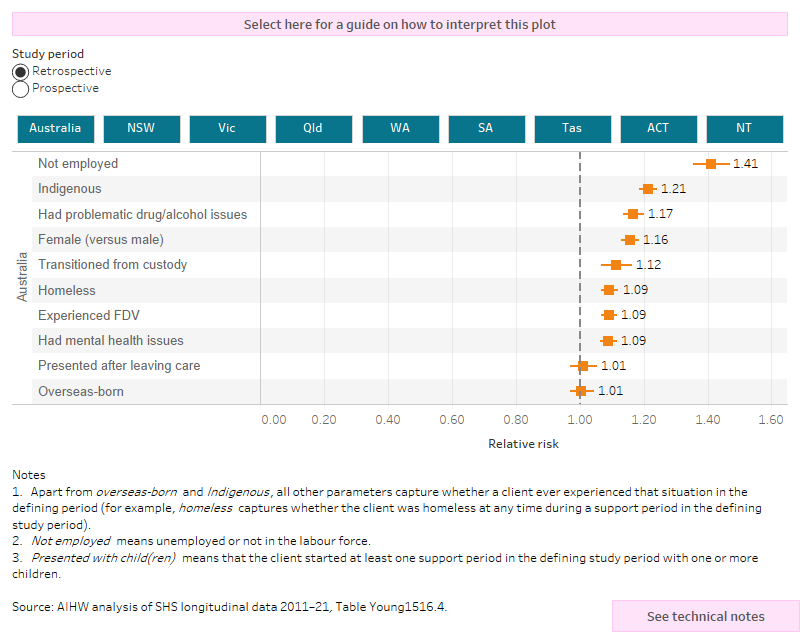
What client characteristics are associated with using SHS services in the prospective study period?
Descriptive regression models were used to examine the association between SHS Young 2015–16 cohort client characteristics and future SHS support. Similar to the models for past SHS support, analyses were undertaken using national data and separately for states or territories with sufficient sample sizes (at least 3,500 clients; Table Young.1, Figure Young.6, Table Young 1516.4).
The results show that, although the associations vary in magnitude within each state or territory, factors such as not being employed (43% greater likelihood), being Indigenous (36% greater likelihood) and being female (21%) were strongly associated with future SHS support. Other vulnerabilities (FDV, mental health issues, drug/alcohol problems, having left care or transitioned from custody) were moderately associated with ongoing service use (14% to 18% more likely).
Summary
Nearly 40,000 young people (aged 15 to 24) presented alone for specialist homeless services in 2015–16. These clients were slightly more likely to be Indigenous and have had mental health issues, and less likely to be born overseas. They were also more likely to have experienced homelessness than young clients presenting with others or aged over 24 years.
They typically had a greater need for short-term or emergency accommodation, or long-term accommodation; short-term accommodation was provided to over 70% of younger clients that required it in the defining period, whereas long-term accommodation was provided to less than 34% of clients that required it.
Younger clients presenting alone were distinct in their need for training assistance, education assistance or employment assistance. Younger clients were also more likely to need pregnancy or family planning support or assistance.
Younger clients have a similar service engagement profile to other clients, in terms of whether they used services in the past or into the future. Not having been employed in the defining study period (that is, in 2015–16), has the strongest association with past or future SHS use, following by being Indigenous.
ABS (Australian Bureau of Statistics) (2018) Census of Population and Housing: Estimating Homelessness, accessed 20 January 2021. Australian Bureau of Statistics: Canberra
AIHW (2020) Health risk factors among Indigenous Australians. Australia's health 2020: snapshots. Australia’s health series no. 17 Cat. no. AUS 232. Canberra: AIHW.
Alves T and Roggenbuck C. (2021) Final Report: Towards a Youth Homelessness Strategy for Victoria, Australian Housing and Urban Research Institute Limited (AHURI), Melbourne.
Brakenhoff B, Jang B, Slesnick N and Snyder A (2015) ‘Longitudinal predictors of homelessness: Findings from the National Longitudinal Survey of Youth-97’. Journal of Youth Studies, 18(8): 1015-1034.
Flatau P, Lester L, Seivwright A, Teal R, Dobrovic J, Vallesi S, Hartley C and Callis Z (2022) Ending Homelessness in Australia: An evidence and policy deep dive, Centre for Social Impact, Crawley.
Flatau P, Thielking M, MacKenzie D, Steen A, Bauskis A and Nolan K (2016) The Cost of Youth Homelessness in Australia, Centre for Social Impact: Crawley.
Flatau P, Thielking M, MacKenzie D and Steen A (2015) ‘The Australian youth homeless experience: Evidence from a longitudinal survey of homeless youth’, Parity, 28(3):4–6.
Gaetz S, Schwan K, Redman M, French D and Dej E (2018) ‘Report 5: Housing Stabilization for Youth’ in A. Buchnea (eds) The Roadmap for the Prevention of Youth Homelessness, Canadian Observatory on Homelessness Press, Toronto.
Grattan R, Tryon V, Lara N, Gabrielian S, Melnikow J, Niendam T (2021) Risk and Resilience Factors for Youth Homelessness in Western Countries: A Systematic Review, American Psychiatric Association, Psychiatric Services In Advance, Published Online: 29 July 2021.
Heerde JA, Bailey JA, Kelly AB, McMorris BJ, Patton GC and Toumbourou JW (2021) ‘Life-course predictors of homelessness from adolescence into adulthood: A population-based cohort study’, Journal of adolescence, 91:15–24.
Heerde JA, Bailey JA, Toumbourou JW, Rowland B and Catalano RF (2020) ‘Longitudinal Associations Between Early-Mid Adolescent Risk and Protective Factors and Young Adult Homelessness in Australia and the United States’, Prevention Science, 21:557–567.
Heerde JA and Patton GC (2020) ‘The vulnerability of young homeless people’, Lancet vol. 5 issue 6, E302–3.
Hodgson KJ, Shelton K.H, van den Bree MB and Los FJ (2013) ‘Psychopathology in young people experiencing homelessness: a systematic review’, American journal of public health, vol. 103 issue 6: e24-e37.
Johnson G, Scutella R, Tseng, Y and Wood G. (2015) Entries and exits from homelessness: a dynamic analysis of the relationship between structural conditions and individual characteristics, AHURI Final Report No.248, AHURI, Melbourne.
MacKenzie D, Hand T, Zufferey C, McNells S, Spinney A and Tedmanson D (2020) Redesign of a homelessness service system for young people, AHURI Final Report 327, AHURI: Melbourne.
Medlow S., Klineberg E and Steinbeck K (2014) ‘The health diagnoses of homeless adolescents: a systematic review of the literature’, Journal of Adolescence, 37(5): 531-542.
Mendes P and Purtell J 2020 ‘Relationship-based Models for Supporting Young People Transitioning from Out-of-home Care: Two Case Studies from Victoria, Australia’, Institutionalised Children Explorations and Beyond, 8(1):120-132.
Pearl B, Harvey C., and Brophy L (2021) ‘Understanding How Young People Exit Homelessness in Australia: A Critical Realist Approach’, Housing, Theory and Society: 1-18.
POA (Parliament of Australia) (2004) ‘A hand up not a hand out: Renewing the fight against poverty’. Report on Poverty and Financial Hardship. Canberra: Senate Community Affairs Reference Committee.
Robards F, Kang M, Steinbeck K, Hawke C, Jan S, Sanci L, Liew YY, Kong M and Usherwood T (2019) ‘Health care equity and access for marginalised young people: a longitudinal qualitative study exploring health system navigation in Australia’, International journal for equity in health, vol. 18 iss. 1:1-4.
Scutella R, Johnson G, Moschion J, Tseng YP, & Wooden M (2012) ‘Journeys Home Research Report No 1: Wave 1 Findings’, Melbourne Institute, Melbourne.
Wang JZ, Mott S, Magwood O, Mathew C, Mclellan A, Kpade V, Gaba P, Kozloff N, Pottie K and Andermann A (2019) The impact of interventions for youth experiencing homelessness on housing, mental health, substance use, and family cohesion: a systematic review. BMC Public Health 19, 1528.
Turnbull L, Chavulak J, Mendes P (2021) What Does Australian Research Tell Us About Best Practice Housing Pathways for Young People Transitioning from Out-of-Home Care?, Monash University Department of Social Work, Melbourne.


